Art World
The 8 Most Embarrassing Art-Heist Fails of All Time, From an Insanely Obvious Dalí Switcheroo to the Getaway Van That Wouldn’t Gogh
"The Thomas Crown Affair" these are not.
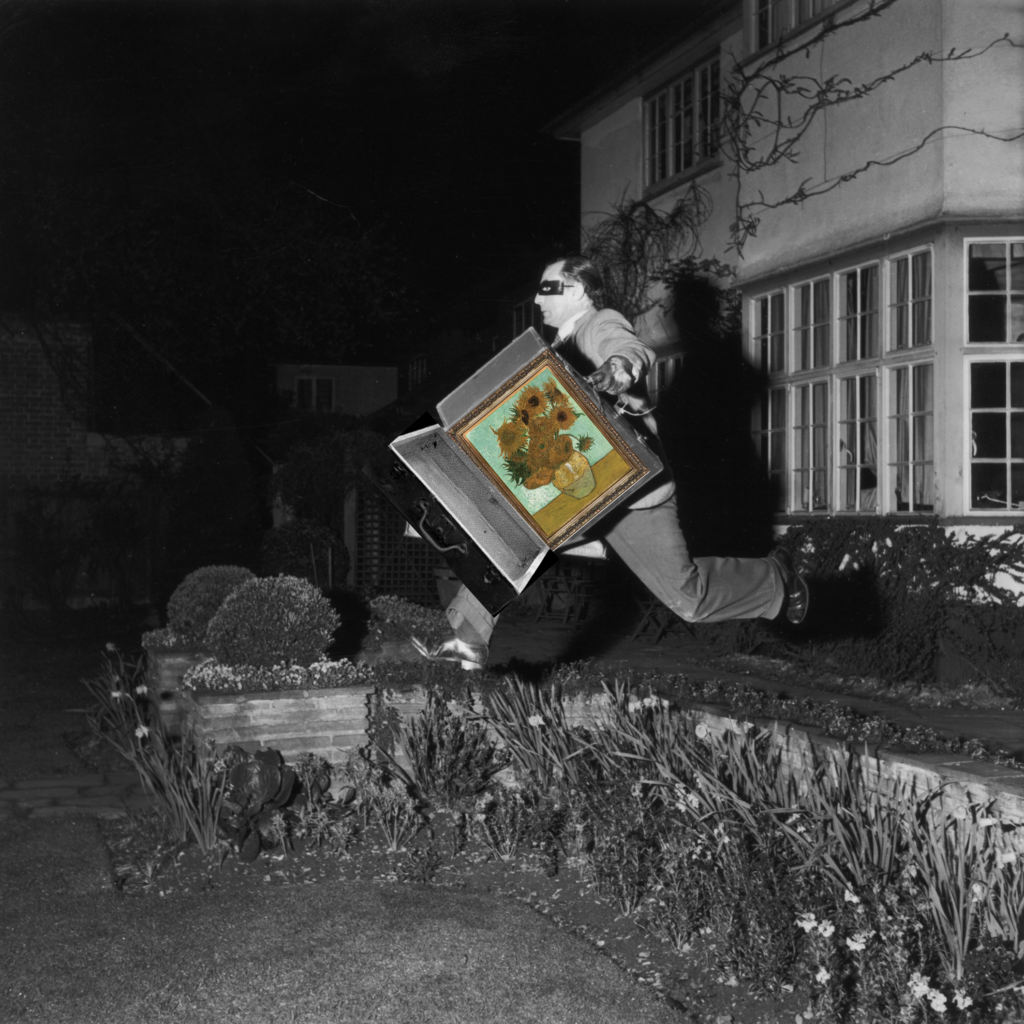
Containing elements of danger, glamour, intrigue, and cunning, art heists have an understandable mystique. These illicit, often multi-million-dollar, feats have made for the premises of some highly entertaining flicks (Entrapment, anybody?). And while crimes like the epic, unsolved robbery of Boston’s Isabella Stewart Gardner Museum, or the acrobatic antics of French art thief and so-called “Spiderman” Vjeran Tomic, give credence to visions of cat burglars dancing through laser security systems, art thefts in reality tend to be far more bumbling.
Be it poor planning on the part of the thief or slipshod security measures, we’ve pulled together a few of our favorite less-than-flawless art heists to bring things back to earth.
Thiefs Fail to Fool With a Crude Dalí Forgery
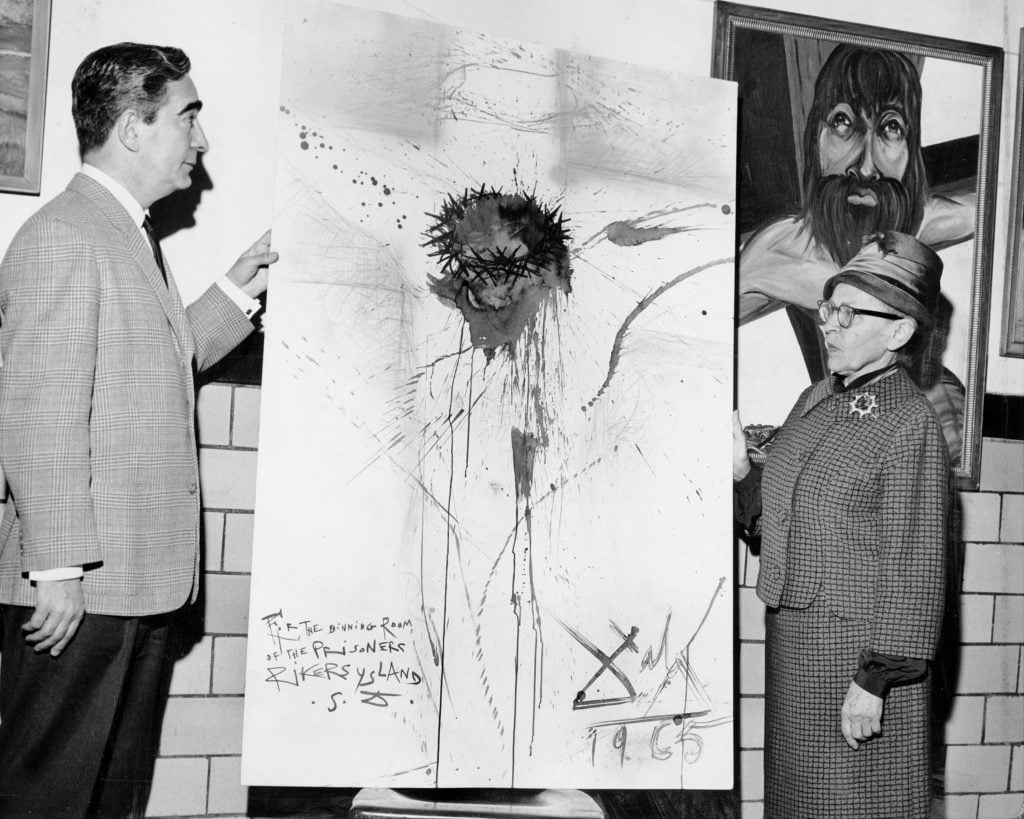
Nico Yperifanos, Salvador Dali’s personal representative, presents the artist’s original Christ on the Cross to Rikers Island prison. Correction Commissioner Anna Kross accepts the work. Photo by Leonard Detrick/NY Daily News Archive via Getty Images.
Let’s start with the peculiar fact that there was a Salvador Dalí sketch housed at Rikers island for nearly 40 years. The artist donated the drawing in 1963 after calling out sick on a day he had promised to teach a one-day art class at the infamous New York City prison. Not wanting to wholly disappoint the inmates, the Spanish artist dashed out an inky depiction of Jesus with a crown of thorns atop his head and cast against a red cross, dispatching the rendering with the inscription that it be placed in the prison cafeteria.
Flash forward decades and, after years of hanging in the cafeteria and getting its fair share of food stains, more cautious officials moved the painting to a sealed-off lobby away from prisoners. But 2003 saw a Shakespearean reversal of roles as four prison guards concocted a scheme to steal the work, believing they could sell it for upwards of $1 million.
The guards’ plan was to set off a phony fire drill, remove the work, and replace it with a forgery. But there was a kink in their plans: none of the guards had any artistic talent. Though they managed to smuggle the Dali out of the prison, their replacement proved lacking and was soon discovered to be a fake.
“The fake Dalí seemed to have been drawn by a child, one with no artistic talent,” the New York Times surmised. Even more tellingly, the forgery was stapled to the back of the Plexiglas case, a bit of a downgrade from its its original gold-leaf mahogany frame. In the end one guard wound up in prison, one on probation, one with a plea deal, and one walking free. The original Dalí has sadly not been recovered.
When It All Goghs Flat

Vincent van Gogh, Still Life: Vase with Fifteen Sunflowers (1889). Courtesy of the Van Vogh Museum.
Car trouble got in the way of what would have been the biggest art heist in history. In April 1991, armed gunmen sacked 20 Van Goghs from the Vincent Van Gogh National Museum in Amsterdam. One of the thieves hid in the museum until after closing, and then let his accomplice in after nightfall.
The gunmen forced the guards (one of whom was later named an accomplice) to disarm the security systems and subsequently tied them up. The duo took a leisurely approach, spending over 45 minutes perusing the works before choosing their favorites, then tucking their selections into garment bags.
But one of the most spectacular heists also turned out to be one of the shortest. The Van Goghs, many from the artist’s late period, were found in a car at nearby railway station less than an hour later. As it turns out, a second car with which the robbers had planned to rendezvous had gotten a flat tire. When the car failed to arrive, the spooked-bandits abandoned the Dutch master’s sunflowers, irises, and potato eaters and hit the road. The artwork, so briefly foisted, was estimated at nearly $500 million in value. Four men, including a guard, were later arrested for the crime.
Spatial Snafu
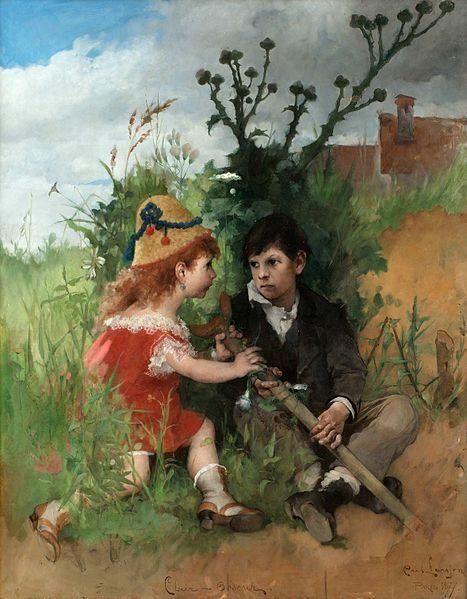
Carl Larsson, Clair-Obscur (1877).
Along with the lock picks, saws, and gloves, thieves may want to consider adding measuring tape to their criminal tool kits. In 2012, a pair of would-be vandals broke into a Stockholm house with plans to abscond with a trio of paintings including Clair-Obscur, a sentimental canvas by painter Carl Larsson, a creator of the so-called Swedish style of painting.
But the bandits hadn’t accounted for the size of their vehicle. When the four-by-three-foot work refused to wedge in, the thieves were forced to ditch the painting, nearly running it over as they fled. The two smaller paintings were discovered in nearby dumpster. Surprisingly, the compact car was an American-made Ford. Next time, better opt for the SUV.
Sometimes It’s the Museum That Blunders

Egyptian police at the Mohammed Mahmoud Khalil Museum in Cairo on August 22, 2010, a day after a Van Gogh painting was cut out of its frame and stolen. Courtesy of Khaled Desouki/AFP/Getty Images.
Fool a museum once shame on you, fool a museum twice, and robbers could wind up with a $50 million Vincent Van Gogh in their hands for the second time in thirty-some years. Cairo’s Mohamed Mahmoud Khalil Museum is home to one of the finest collections of European 19th-and 20th-century art in the Middle East, but what it boasts in Impressionist masterpieces, it seemingly lacks in security infrastructure.
Vase With Flowers (ca. 1887), commonly known as Poppy Flowers, was first lifted from the museum in 1978 under undisclosed circumstances, only to be retrieved in Kuwait several years later. Experience did not prove the greatest teacher in this case : the small, one-by-one-foot painting was pilfered from the museum again in 2010. A comedy of errors commenced, as authorities soon after wrongly announced that the painting had been retrieved from an Italian couple at the Cairo airport, only to retract the statement soon after.
As for the bandits, this caper was a cakewalk: only seven out of the museum’s 43 security cameras were functional at the time of the crime. The thieves were even able to pull up a couch while they cut the work from its frame. And though only 10 visitors entered the museum that day, the perpetrators and the whereabouts of the artwork remain unknown to this day.
The Students Inspired by ‘Oceans 11’
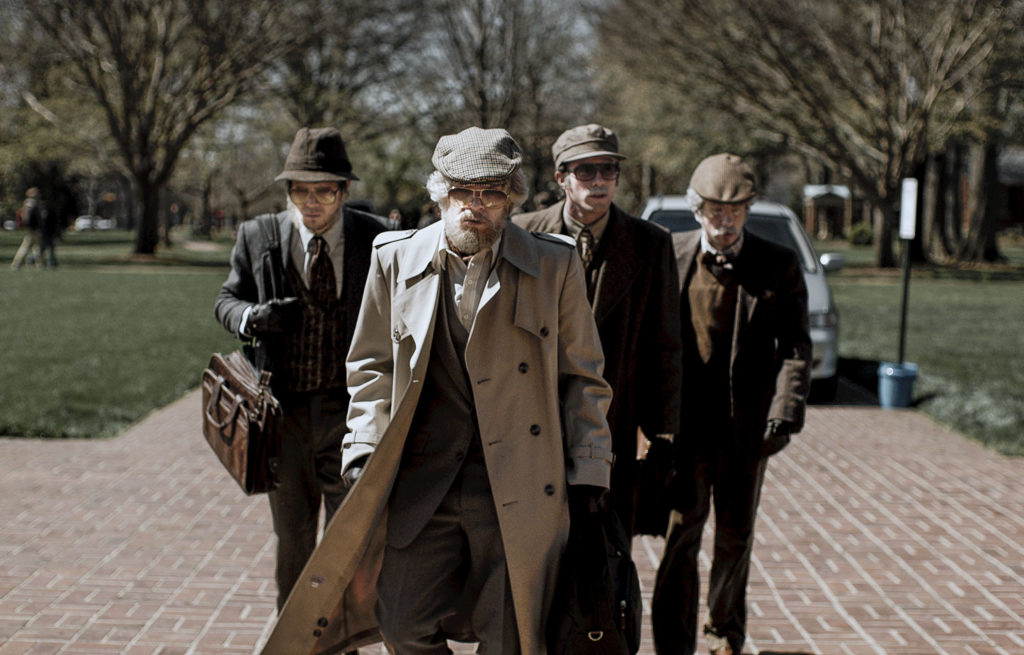
Still from American Animals (2018).
One too many high-stakes crime films seem to be behind the real-life fiasco that inspired the 2018 film American Animals. In 2004, four Kentucky students with dreams of grandeur attempted to sack millions of dollars of rare books from their university library, which included a first edition copy of Charles Darwin’s Origin of Species and drawings and sketches by naturalist John James Audubon. The students, who said they had obsessively watched heist films like Oceans 11 in the lead up, hoped to sell the books through a dubious set of underground connections. Instead, they wound up in prison.
What went awry is more a matter of where to begin. The students’ half-baked plot included scheduling a daytime viewing at Transylvania University’s Rare Books Collections where they would incapacitate the librarian, then trundle their loot to a waiting getaway car. In a first failed attempt, the crew arrived to their viewing costumed as old men in thick suits and false mustaches. Arriving at the library only to realize more than one librarian was on staff that day, the boys scrapped the plan for that day.
Soon after, they gave it another go, returning this time without costumes. One student tasered the librarian, who, instead of falling unconscious as they had planned, began to scream in pain. The posturing thieves had likewise underestimated the weight of the books, and haphazardly dropped and abandoned many of them as they fled out one of the public doors.
The students, who had timed their crime to the alibi of final exams, shockingly went without capture for weeks, even driving north to Christie’s in New York with the hopes of receiving certificates of authenticity for their illicit reading materials. But a digital slip-up queued the crew’s imminent demise: one of the students booked the Christie’s appointment using the same email account with which he’d scheduled his criminal library viewing. Soon after, the FBI busted down each of their doors. The crew of four each refused to testify against one another, all winding up with identical seven-year sentences.
A Gallery Robbery Kiboshed by Carousing College Kids
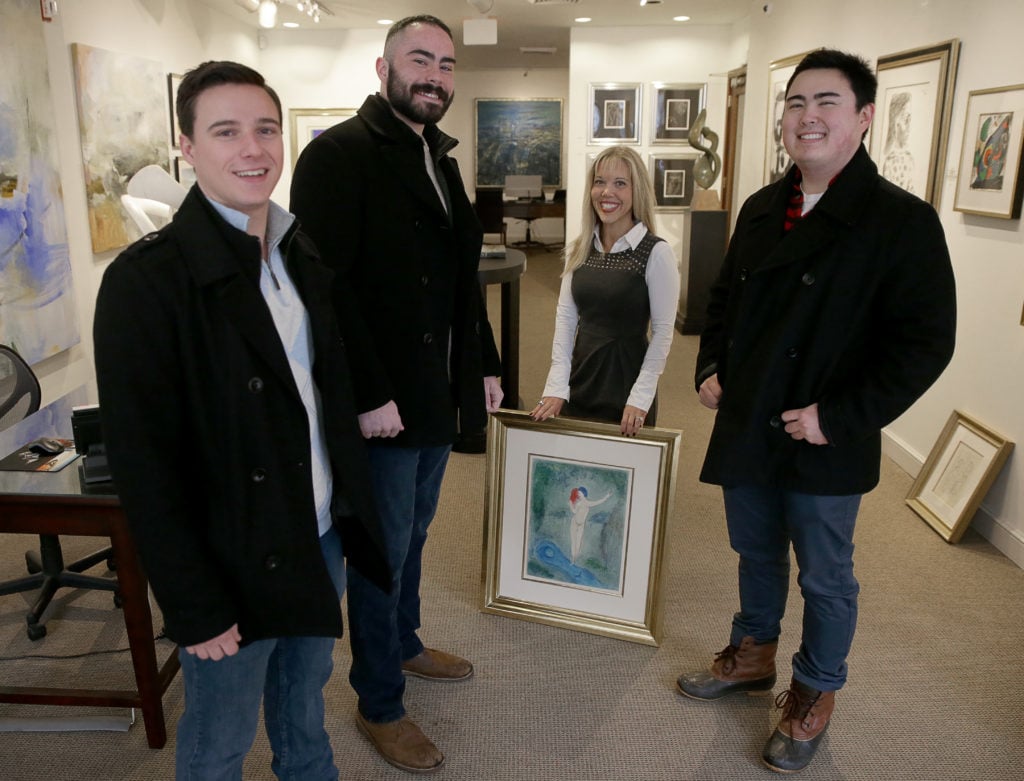
Galerie d’Orsay co-owner Sallie Hirshberg holds a painting involved in an attempted theft which was foiled by Boston University Students Chris Savino, far left, Mackenzie Thompson, second from left, and Jesse Doe, far right. Courtesy of Jonathan Wiggs/The Boston Globe via Getty Images.
It’s got to be a sad day in the land of thieves when a robbery can be halted by college students coming off Super Bowl festivities. In February 2017, just after midnight, three Boston University students were walking back to campus after the Patriots Super Bowl win when they spotted a man suspiciously emerging through the smashed glass door of the Galerie d’Orsay, holding what turned out to be stolen works of art.
Despite any preceding celebratory antics, the students, Chris Savino, Jesse Doe, and Mackenzie Thompson, sensed something was off and pursued the thief down the street, retrieving the works and accosting the criminal, 29-year-old Jordan Russell Leishman, until police arrived. Leishman, who was arrested for breaking and entering, had decent taste, selecting etchings by Miró and two Chagalls, but ultimately had missed some heavy hitters including a Picasso and Rembrandt that were also on view in the gallery.
A Museum’s Criminally Lax Security
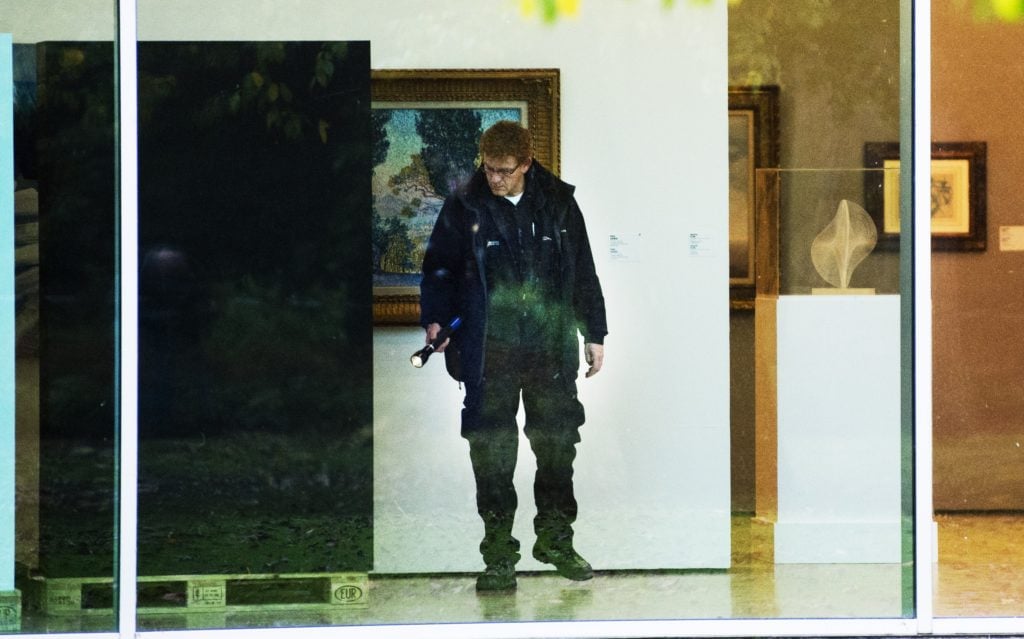
A investigator searches the Rotterdam Kunsthal museum break-in during the night on October 16, 2012. Courtesy of Robin Utrecht/AFP/Getty Images.
In 2012, Romanian thief Radu Dogaru masterminded a spectacular $24 million robbery of Rotterdam’s Kunsthal museum, efficiently plucking works by Picasso, Monet, and Gauguin from the walls in under 90 seconds. The pre-dawn heist was valued at more than €200 million.
But in a bizarre turn of logic, the deft criminal claimed to be a victim of the museum’s relaxed security measures and attempted to sue the museum for making things too easy. “I could not imagine that a museum would exhibit such valuable works with so little security,” he opined in his court hearing.
After his arrest, Dogaru’s mother claimed to have burned the seven stolen works in an oven, only to later retract the statement. Four people were ultimately pinned for the crime, with Dogaru as the ringleader. In 2018, in one more bizarre turn, a Belgian theater group pranked the ever hopeful museum when, as part of a publicity stunt, they staged finding Picasso’s Tête d’Arlequin, one of the looted works (valued at nearly $800,000) using a forgery.
A Renegade Thief’s Costly Lesson
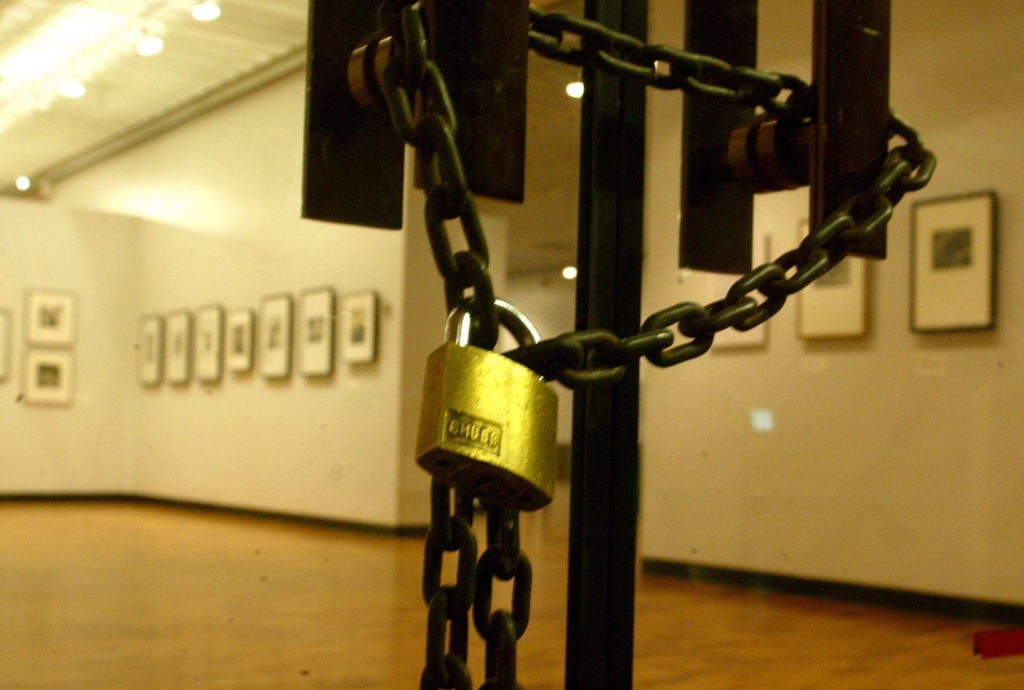
In 2003 a thief stole works by Van Gogh, Picasso, and Gaugin from Manchester’s Whitworth Art Gallery, supposedly in an attempt to highlight its poor security. Courtesy of Phil Noble, PA Images via Getty Images.
When three works by Picasso, Van Gogh, and Gaugin were snatched out of Manchester University’s Whitworth Art Gallery in 2003, it was, quite poetically, a dark and stormy night—one of the city’s rainiest in history. Undeterred, or perhaps even encouraged, by the inclement weather, a thief purportedly pried open the steel-covered doors at the back of the museum and pilfered the three works without ever tripping an alarm system or appearing on video surveillance.
At 2 a.m. that night, the police received a mysterious call that the works had been “found” in a dilapidated public lavatory nearby. When the police arrived they found not only the three works rolled up in a cardboard tube, but also a handwritten note which read, “We didn’t intend to steal these paintings, just to highlight the woeful security.” The works, which had slight weather damage, were soon returned to the museum.
Follow artnet News on Facebook:
Want to stay ahead of the art world? Subscribe to our newsletter to get the breaking news, eye-opening interviews, and incisive critical takes that drive the conversation forward.
SHARE

Article topics






